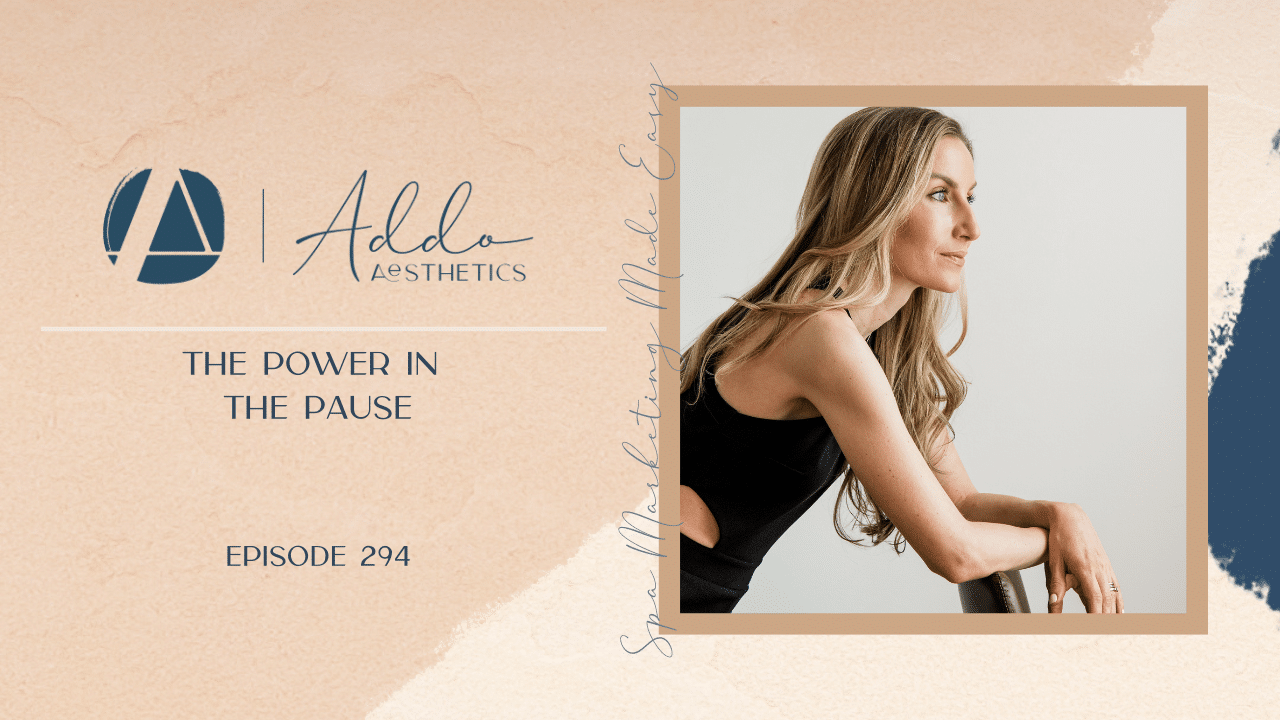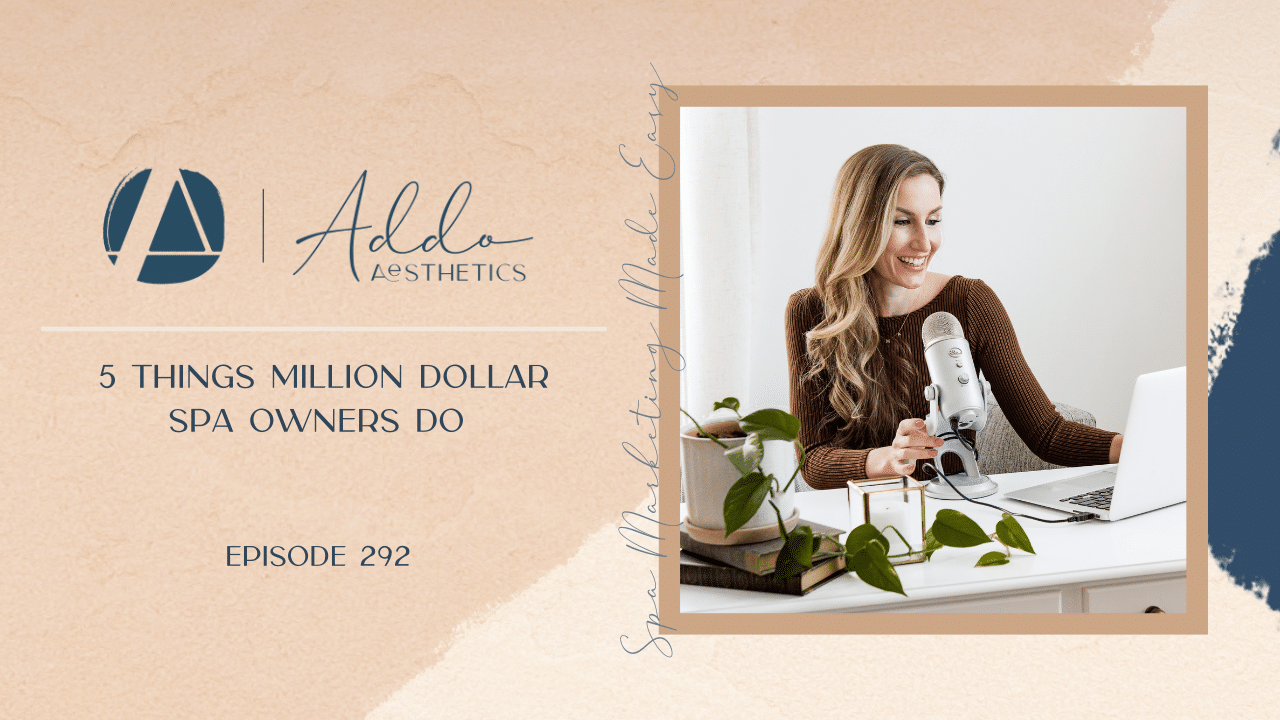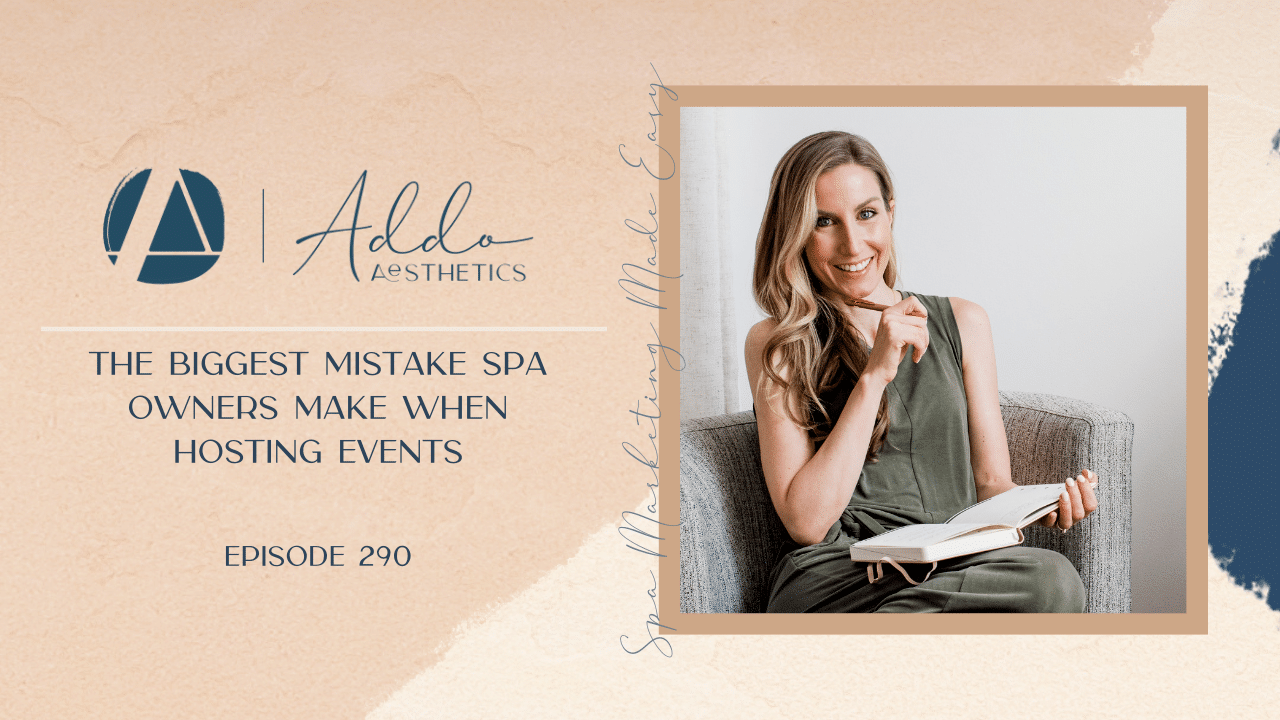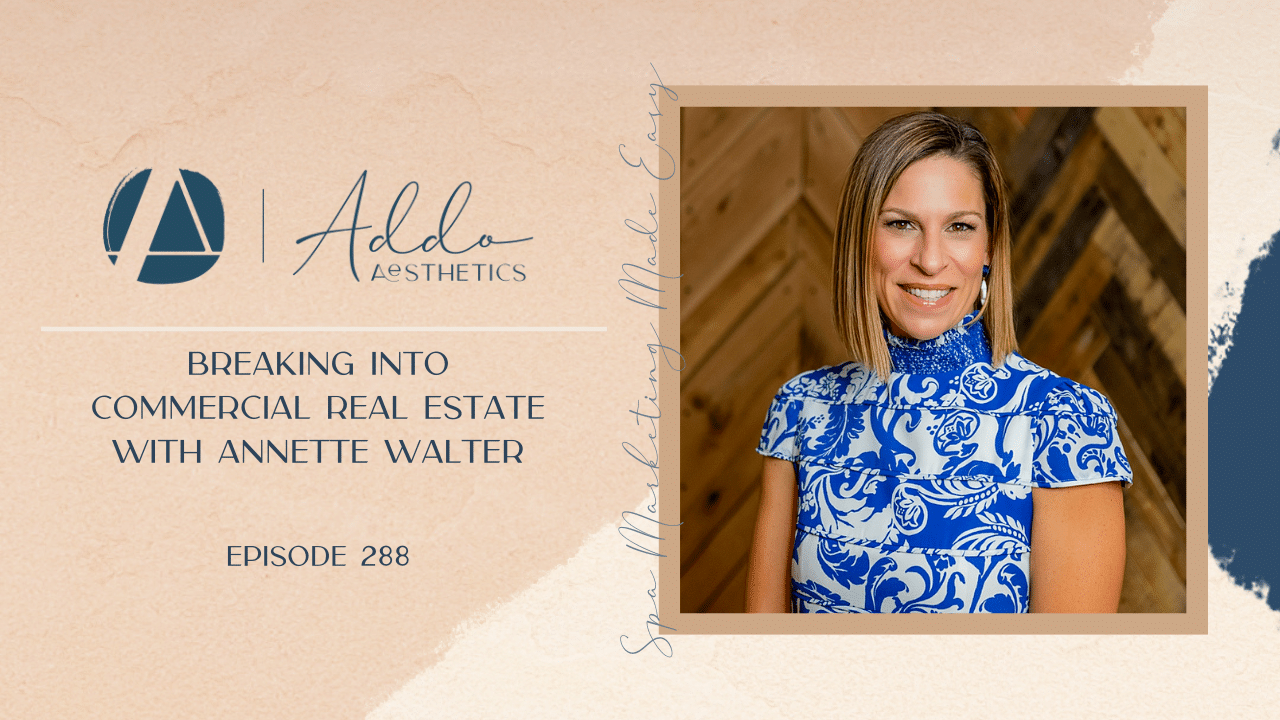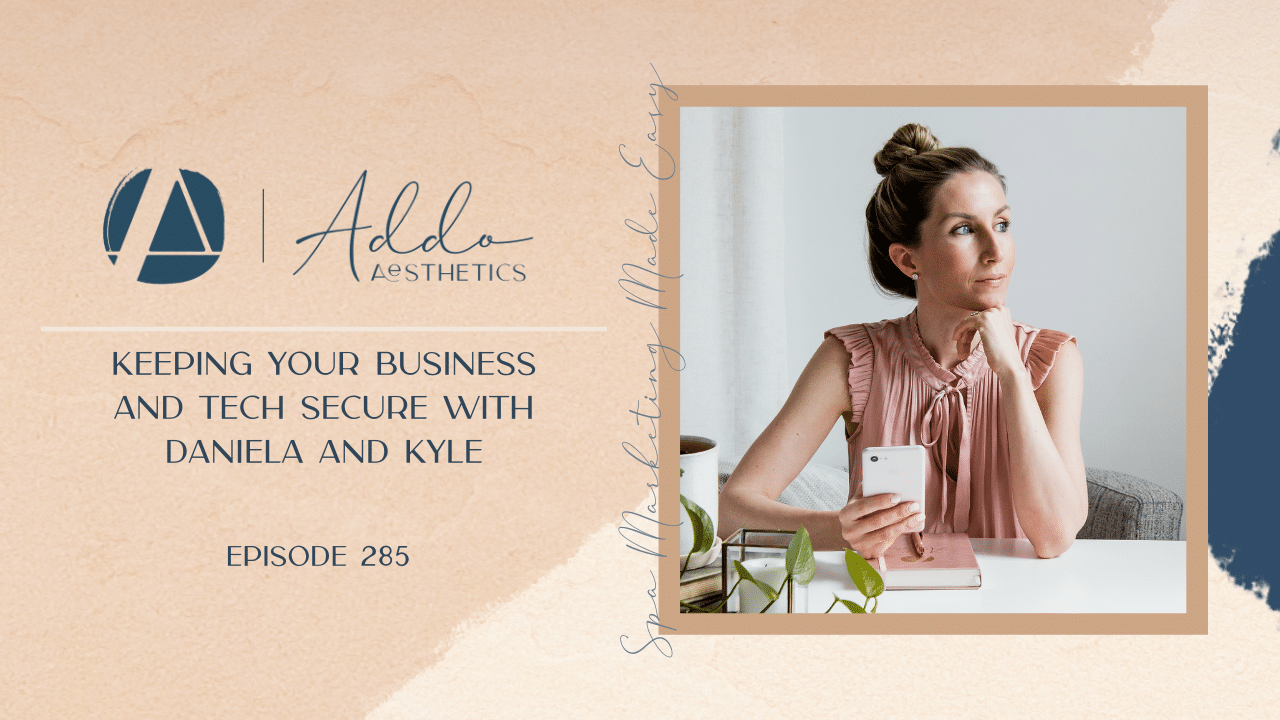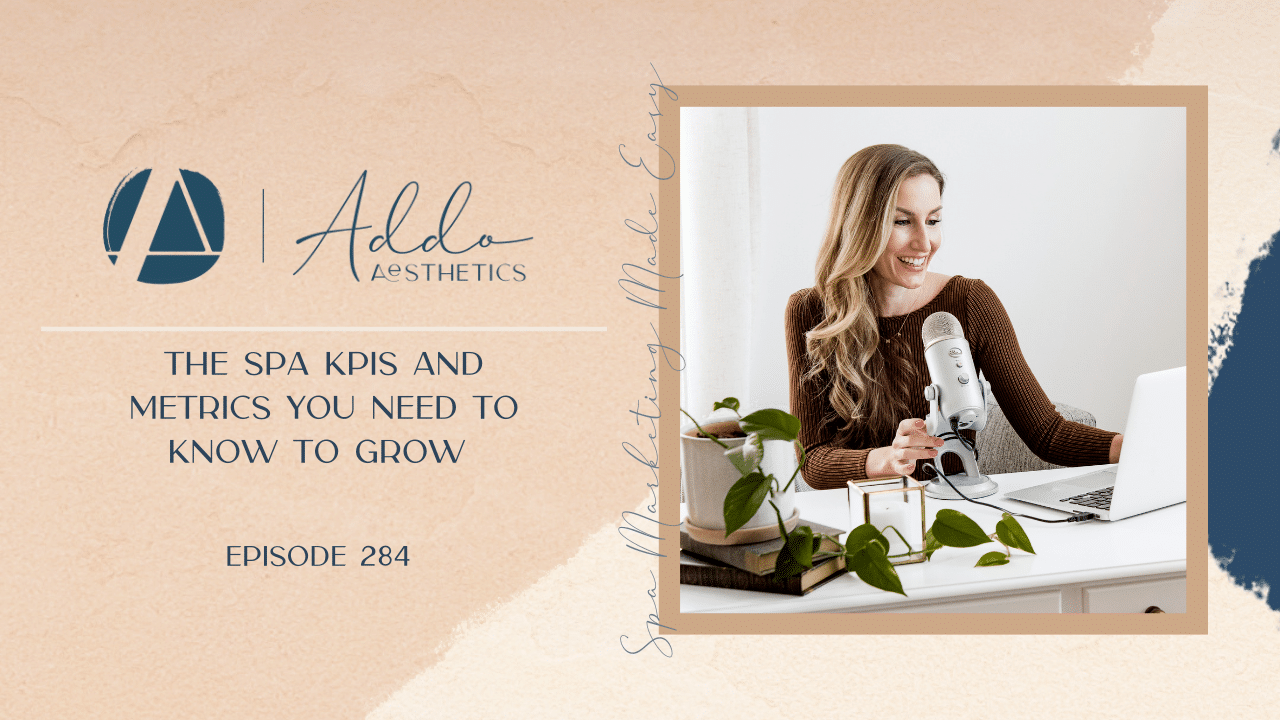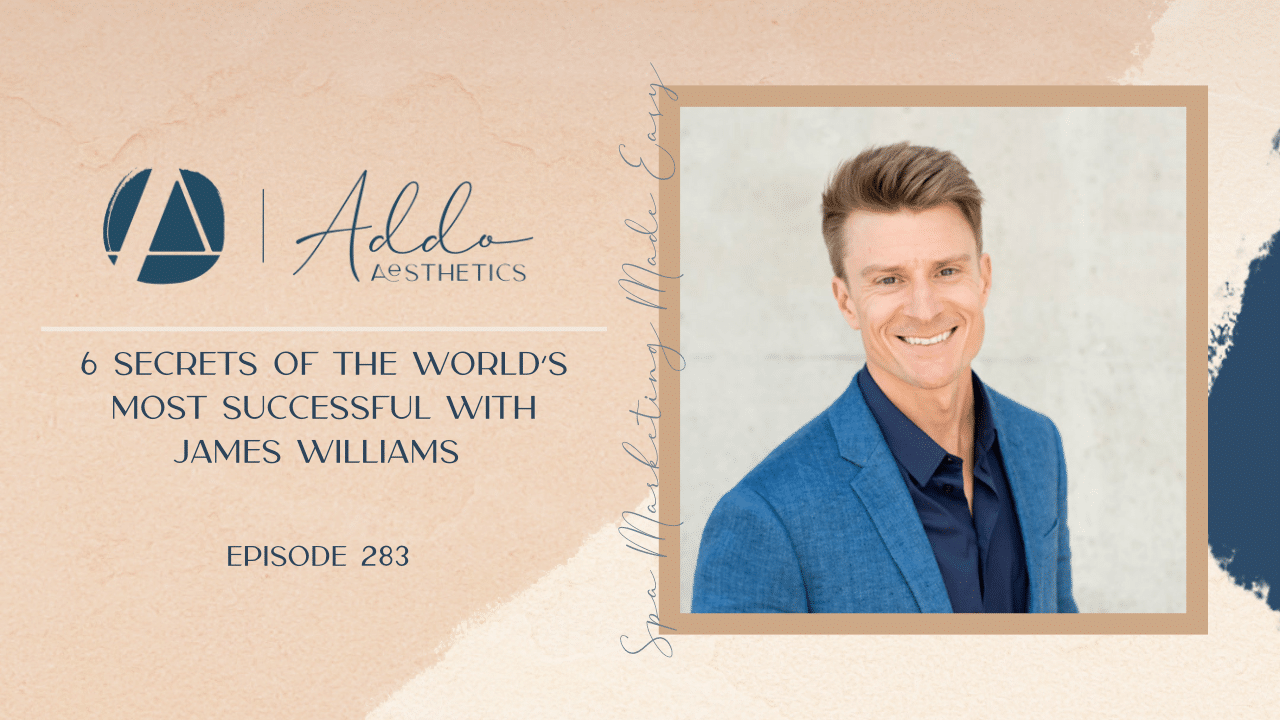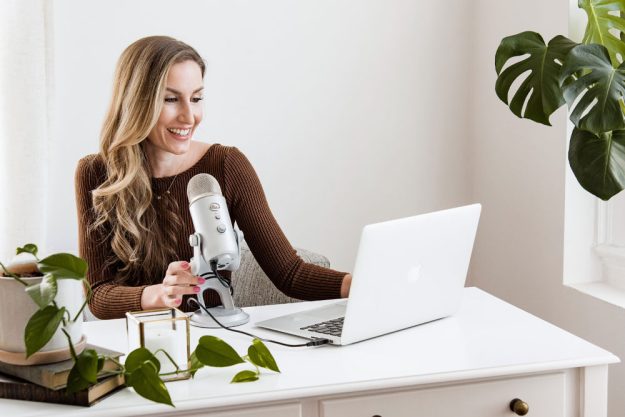
Catch the Latest Episode of Spa Marketing Made Easy
As a spa professional, one of the biggest keys to creating a life you love is getting more clients in the door. Easier said than done, right? With the Spa Marketing Made Easy Podcast, you can get all the tools you need. Join host Daniela Woerner, licensed esthetician, to get simple, proven strategies for marketing your spa business.
Ever feel like you’re working so hard to make your business grow that you hardly have a moment to relish in what you’ve built?
How about feeling like despite your best efforts, you feel stagnant in your spa’s growth and you’re barreling toward burnout?
Newsflash for you: growth doesn’t always come from going, going, going toward your goals like the Energizer Bunny.
In fact, that can hinder, rather than help your growth, especially in the long run. And if we’re building businesses that we hope to make strong not just in the next year, but in the decades to come, we have to look at the ebbs and flows of growth holistically.
Sometimes, it’s the ebbs, the slowdown,The Pause, that holds the greatest power in harnessing your energy and resources helping you to grow in new ways.
In this episode, you’ll hear:
- How to identify the time to grow and the time to pause in business
- Why pausing is a form of personal self-care and how it can serve as a time to shift into the next stage of growth for your business
- Examples of what taking a pause can look and feel like
- A personal story of pausing that you can pull from when you start to doubt if you’re making progress or gaining traction while taking a break
References Mentioned in Episode #294: The Power in the Pause
- Learn more about Growth Factor Framework, my signature program for stepping into your role as Spa CEO, by clicking here
- To keep the conversation going, ask questions, and connect with other like-minded aestheticians building thriving careers, click here to join the free Spa Marketing Made Easy Podcast community.
Episode Transcript
Wish you could peek behind the curtain on what goes into hosting a wildly successful spa event?
Lucky for you, in this episode of Spa Marketing Made Easy, I’m talking with Kerri VanEe, one of my Spa CEOs from my Growth Factor Framework program about all the ins, outs, ups and downs of hosting her first spa event, which resulted in a whopping $90K in revenue that came in during the event and in the months to follow.
If you don’t have the pleasure of knowing Kerri from inside the Growth Factor Framework community, you should know that she’s an Advanced Registered Nurse Practitioner who has spent the last 20 years in the healthcare field, and she opened Essence Aesthetics and Health, a medical spa in a small rural Iowa town, in March 2021.
That’s right, smack dab in the middle of a pandemic.
At Essence Aesthetics, Kerri and her team of Registered Nurses provide personalized medical grade aesthetic treatments as she works to empower her clients to show up more confidently and as their best selves.
And after just 14 months of being open and hosting her successful birthday celebration event, which is what we break down in this episode, she is currently doubling her team.
It goes without saying that Kerri’s a bonafide businesswoman, and the lessons she’s sharing in this episode are a must for Spa CEOs at every level to take note of.
In this episode, we discuss:
- How Kerri launched into owning her spa in the middle of the pandemic and what her goals looked like before settling on running an event
- Kerri’s backstory to the “why” behind her event and how she began to set the framework for what her event would look like
- What planning for the event looked like in terms of timeline, team, marketing efforts
- How her event took shape including the offer and what the event entailed, and of course, the results!
References Mentioned in Episode #293: Creating a $90K Cash Infusion with Her First Spa Event with Kerri VanEe
- Learn more about Kerri’s spa, Essence Aesthetics, via their website, and connect with them on Facebook and Instagram
- Listen to Episode #251: Hosting 5-Figure Spa Events with Taylor Moody
- Listen to Episode #267: Scaling from Solo and “Doing it Scared” with Allison Cremona
- Listen to Episode #290: The Biggest Mistake Spa Owners Make When Hosting Events
- To keep the conversation going, ask questions, and connect with other like-minded aestheticians building thriving careers, click here to join the free Spa Marketing Made Easy Podcast community
Episode Transcript
Do you want your spa to reach the coveted seven-figure benchmark?
That might sound like a trick question, but honestly, it’s a valid one.
More money requires more of you to uplevel into being a Spa CEO, but if hitting the million dollar benchmark is a goal you’d like to hit in your business, then listen up, because I’ve got good, and possibly surprising, news for you…
Hitting a million dollars in your spa may not be as big of a mountain to climb as you may think.
In fact, I’d argue that reaching the six-figure mark is much tougher.
But if the million dollar mark is what you have your sights set on, then this week’s episode of Spa Marketing Made Easy is for you as I share the five things that million-dollar Spa CEOs do.
From specific action steps to mindsets and perspectives, these are the things I find all the top Spa CEOs who hit the million that I’ve had the honor of working with have in common.
In this episode, you’ll learn about:
- How to look at your metrics and numbers to be able to hit your bigger vision goals
- Finding areas of opportunities in your business that you and your team can leverage
- The common perspectives and mindsets that million-dollar Spa CEOs share
- What things million-dollar spa owners do on the tangible and mindset levels to get ahead personally and professionally
References Mentioned in Episode #292: 5 Things Million Dollar Spa Owners Do
- Learn more about my signature program for Spa CEOs, Growth Factor Framework here
- Tune into Episode #284 – The Spa KPIs and Metrics You Need to Know to Grow
- To keep the conversation going, ask questions, and connect with other like-minded aestheticians building thriving careers, click here to join the free Spa Marketing Made Easy Podcast community.
Episode Transcript
When it comes to revving up your retail revenue, one of the most common avenues spa owners explore is private label. But often private labels can leave much to be desired in terms of what you, and your customers, actually want out of a product, especially one with your brand name on it.
Enter: custom formulations.
If you’ve ever considered creating your own product line from the ground up, you’re going to love this episode of Spa Marketing Made Easy!
Joining me on the mic is Lorraine Dallmeier; Lorraine is the award-winning CEO of Formula Botanica, an online organic cosmetic formulation and business school which has trained over 14,000 organic formulators and indie beauty entrepreneurs in 175+ countries. A Biologist and Chartered Environmentalist by training, Lorraine is on a mission to teach the world to make formulation as commonplace as cooking.
Awarded Digital Achiever of the Year by Google and Cosmetic Executive Women (CEW) in 2018 and voted most influential person in the global natural beauty sector for 2020, Lorraine is a force to be reckoned with in the world of formulation, something she started as a side hustle while on maternity leave that has led to a $6 million global eLearning empire with a team of 40.
Whether you’re just inkling with the idea of creating your own custom formulations, or you need an inspiring story of growing your empire, you’re going to love our discussion in this episode!
References Mentioned in Episode #291: Formulating Your Own Products with Lorraine Dallmeier, CEO of Formula Botanica
- Learn more about Formula Botanica by visiting their website and enroll in their free course, “Learn How to Become an Organic Skincare Formulator” by clicking here
- Connect with Formula Botanica on Instagram and Facebook
- Connect with Lorraine Dallmeier on Instagram and Facebook
- Check out the brands Lorraine mentioned in this interview, NOPALERA and Naughty Alchemist
- To keep the conversation going, ask questions, and connect with other like-minded aestheticians building thriving careers, click here to join the free Spa Marketing Made Easy Podcast community.
Episode Transcript
You know that hosting an event for your spa can lead to a nice cash infusion, but you also know that an event has the potential of costing more than it brings in – in money, time, and energy.
Sure, there’s plenty of marketing you can do to take your best shot at making your event a success, but when it’s all said and done, you’re still afraid that hosting an event could be too much of a roll of the dice.
Rather than making the move of hosting an event for your spa a marketing coin toss, tune into this short and sweet episode of Spa Marketing Made Easy where I’m sharing the number one mistake to avoid so you can kick off planning an event so that it’s a smashing (i.e. highly profitable) success!
In this episode, you’ll learn:
- The number one mistakes spa owners make when planning to host an event in their spa
- Questions to ask yourself when planning your spa event
- How to tie your business goals to the offer you’ll present at your spa event
- Evaluating the success of your event based on the timeline that aligns with your goal
- How the planning process and marketing differs based on your event goal
References Mentioned in Episode #290: The Biggest Mistake Spa Owners Make When Hosting Events
- Listen to Episode #251: Hosting 5-Figure Spa Events with Taylor Moody
- Listen to Episode #267: Scaling from Solo and “Doing it Scared” with Allison Cremona
- Learn more about the project management software we use at Addo Aesthetics; monday.com
- To keep the conversation going, ask questions, and connect with other like-minded aestheticians building thriving careers, click here to join the free Spa Marketing Made Easy Podcast community.
Social media tends to be the hot topic when it comes to digital marketing, and while it is a crucial pillar in your overall marketing strategy, there’s another pillar that is equally as important, but is often overlooked – but not today!
I’m talking about SEO aka Search Engine Optimization, and here to discuss it with me on this episode of Spa Marketing Made Easy is Caitlin Strempel.
Caitlin is an SEO expert and marketing success coach who helps business owners get to the top of their industry by getting to the top of Google and found online at her company, Rising Ranks Digital.
Caitlin has worked with locally-based businesses all the way to large-scale global brands such as Under Armour, Lexus and more, and she’s proud to have a 100% success rate at getting her clients to the first page of Google, which is something she’s going to share her top tips on in this episode.
Whether you’re a spa owner who has no idea what SEO is or the faintest idea of how to get it to work, or you’re a tad familiar, but know you could beef up your efforts to gain better traction on Google, this episode is a must-listen!
In this episode, we discuss:
- What SEO is and why it’s especially important from a local business perspective
- The first step to getting started with honing in on your SEO efforts and Caitlin’s top recommended tool to use
- Using organic SEO efforts alone and alongside a paid Google ads strategy
- When spa owners should look into investing more time, effort and money into ramping up their business’ SEO
References Mentioned in Episode #289: Using SEO to Rise the Ranks of Google with Caitlin Strempel
- Learn more about Caitlin and her company Rising Ranks Digital on her website
- Connect with Caitlin on Instagram
- Check out Caitlin’s top recommended keyword research tool, Ubersuggest
- Listen to Episode #219 of Spa Marketing Made Easy: Getting Found through Search and SEO with Neil Patel
- To keep the conversation going, ask questions, and connect with other like-minded aestheticians building thriving careers, click here to join the free Spa Marketing Made Easy Podcast community.
Episode Transcript
As you work toward becoming a Spa CEO and putting the systems and structure in place to allow your business to thrive without your hands being the one to turn the gears, something becomes abundantly clear; your money, when leveraged, can begin earning on its own.
Now, there are plenty of ways to create this leverage, but one way that spa owners in particular can benefit from is owning the space where you operate your spa aka commercial real estate.
Here to talk with me about it in this episode of Spa Marketing Made Easy is Annette Walter, the CEO of Timber Industries, which is the largest 100% women-owned pallet, crating and lumber distributor in the U.S., as well as iEvolve Consulting, a growth, strategy and operations business coaching firm.
In this episode, we’re diving into the topic of investing in commercial real estate to help diversify and grow your wealth, and if this topic has you feeling a little hesitant (as in the “who am I to…” variety), this episode is especially for you.
And if owning your space, or future space, has ever crossed your mind, I know you’re going to love this conversation!
In this episode, we discuss:
- How Annette broke into the world of commercial real estate and why now might be the best time to begin your foray into this space
- The 101 on how financing and real estate transactions work in comparison to residential real estate and what the pathway to owning commercial real estate looks like
- Who you should have on your internal advisory board to help you make the most sound financial decisions both personally and professionally
- What you need to have to begin looking into commercial real estate opportunities – spoiler: it’s not as intense as you think!
References Mentioned in Episode #288: Breaking into Commercial Real Estate with Annette Walter
- Learn more about Annette’s operational strategy and business coaching company, iEvolve Consulting, visit her website
- Connect with Annette on Instagram, LinkedIn, and Facebook
- To keep the conversation going, ask questions, and connect with other like-minded aestheticians building thriving careers, click here to join the free Spa Marketing Made Easy Podcast community.
Episode Transcript
If you have the dream of growing your spa or aesthetic business beyond its first six figures, building a team is a non-negotiable.
And a non-negotiable element to a top-performing team is one that communicates clearly, kindly, and efficiently.
Furthermore, you need to build a business that doesn’t rely on you, the Spa CEO, as the foundation…
But what’s the best way to ensure that the team you are building is going to help you build for the long-haul?
In this episode of Spa Marketing Made Easy, I’m talking about why understanding your MBTI personality type and those of your staff and team make all the difference in your hiring process and thus, creating a company with a strong infrastructure for growth.
In this episode, you’ll learn:
- What the MBTI Personality entails and what each letter determines about someone’s personality
- Why MBTI is my go-to personality assessment tool for hiring new team members and understanding my team member’s communication style
- How to assess your team’s individual personality assessments to fit your business’ team needs
- How you can utilize MBTI has a filtering tool during the hiring process
References Mentioned in Episode #287: Understanding MBTI to Build Your Top Performing Team
- Take the MBTI Personality test on 16Personalities
- Check out other personality assessments including StrengthsFinder, Kolbe Type Indicator and Enneagram
- Learn more about Dr. John Gottman and Carl Jung’s work
- To keep the conversation going, ask questions, and connect with other like-minded aestheticians building thriving careers, click here to join the free Spa Marketing Made Easy Podcast community.
Episode Transcript
If there’s one word that encompasses nearly every entrepreneur’s desire to build a business, it’s “freedom.”
Freedom to unlimited earning potential, freedom to work on your terms, freedom to grow in whatever direction you desire.
The freedom to choose.
In this week’s short and sweet episode of Spa Marketing Made Easy, my goal is to get you thinking about what freedom means to you as a Spa CEO and as someone who deserves to live a rich and full life.
In this episode, I discuss:
- Why getting clear on your definition of “freedom” helps you to define your goals and growth path
- How freedom is multifaceted between life and business, and what it is that freedom means in the tangible sense
- What elements of freedom mean the most to me and why, plus how those freedom goals have shifted for me over the years and as my life and life circumstances have evolved
Resources Mentioned in Episode #286: What Does “Freedom” Mean to You?
- To keep the conversation going, ask questions, and connect with other like-minded aestheticians building thriving careers, click here to join the free Spa Marketing Made Easy Podcast community.
Episode Transcript
We always think it’ll never happen to us, but the reality is, it could happen to anyone and I’ve seen it for myself.
I’m talking about your spa business getting hacked.
It’s one of those things we just don’t want to imagine or simply believe that it only happens to “big, household name” companies, but the truth is, data breaches and security hacks can happen to any business of any size.
And no matter what the size of your business, the results can be devastating.
That’s why in this week’s episode of Spa Marketing Made Easy, I’m sitting down with my husband, Kyle, an MIT engineer and my resident tech wizard, to talk about all things cyber-security and good computer hygiene so that you can keep your business safe and secure in our digital world.
Now I know this isn’t a “sexy” business topic like revenue growth, profit potential, social media, or marketing, but without securing the house you’re building, you’re putting your business at a huge risk of losing the gains you’re working so hard to make.
The truth is, topics like this are topics that Spa CEOs need to concern themselves with, and the good news is that if you simply become aware of these things and take the proper steps to either set yourself up for cyber-safety from the get-go, or carve out some time to create your cyber-secure systems, you can move forward knowing you’re operating with a safe and secure foundation.
In this episode, we discuss:
- My personal experience working with a spa that got hacked and how it impacted their business
- The steps you need to take online to ensure your passwords are truly strong and secure
- Considerations around backing up your business’ data and crafting credentials that further secure your business’ information
- Our go-to password protection tool that we use to help onboard and offboard team members while ensuring our security information stays safe
References Mentioned in Episode #285: Keeping Your Business and Tech Secure with Daniela and Kyle
- Sign up for LastPass, which is what Team Addo uses to manage passwords and keep them secure
- To keep the conversation going, ask questions, and connect with other like-minded aestheticians building thriving careers, click here to join the free Spa Marketing Made Easy Podcast community.
Episode Transcript
It’s a business topic that often makes spa owners want to run for the hills or bury their heads in the sand, but I promise if you stick with me for this episode, I’ll make it worth your while, and a lot less scary…
That’s right, I’m talking about metrics aka KPIs aka your numbers.
You may think it’s the most unsexy thing to think about in business, but it’s so critical to understanding where you’re currently at in the health of your spa business, and tracking your progress to grow to the level you ultimately desire.
Stick with me through this short episode where I’m covering the most critical KPIs you need to be tracking inside your spa, and you’ll see that knowing your numbers is actually quite desirable, and not nearly as intimidating as you think.
You in?
Let’s go!
In this episode, you’ll learn:
- What KPIs are and what they help you achieve in your business
- The 4 KPIs that are crucial for every spa owner to be tracking
- How the benchmarks for these numbers can differ depending on your spa’s business model and what to look for to see if you’re leaving money and earning potential on the table
- A simple breakdown of the “Revenue Per Hour Per Room” metric on a spa earning a million dollars in revenue to showcase how this is a 100 percent possible goal
References Mentioned in Episode #284: The Spa KPIs and Metrics You Need to Know to Grow
- Listen to Episode 225: Becoming a Profitable Shareholder of Your Business with Mike Michalowicz, the author of Profit First
- To keep the conversation going, ask questions, and connect with other like-minded aestheticians building thriving careers, click here to join the free Spa Marketing Made Easy Podcast community.
Episode Transcript
To start a business and become an entrepreneur means you are a high achiever, but being a high achiever – one with big goals, dreams, and vision – doesn’t necessarily equate to being a high performer.
However, as you might have guessed, being successful in achieving your goals and doing so in a way that leaves you fulfilled, energized, and purposeful, does require high performance.
In this episode, which was a coaching call inside of the Growth Factor Framework program, my guest, James Williams shared a fantastic presentation based on real-world data on the world’s most successful people, and what we can glean from them, and I knew I had to share it with everyone in the Spa Marketing Made Easy community.
James is a Performance Breakthrough Coach, founder of The Growth Edge, and speaker who is passionate about focusing on creating outer world impact through inner world mastery.
His passion for mastering physical, mental and emotional performance in pursuit of his own life goals is only matched by his dedication to supporting his clients’ belief that anything is possible and available for them.
As you listen in, I really want you to be honest with yourself on the answers to some of the questions he raises as he works through the six secrets, and also know that you are 100 percent capable of being a high performer if you’re not quite meeting the benchmarks needed to perform at your highest level.
The hardest work we have to do as entrepreneurs is directly between the ears, and you, my dear listener, are capable of anything you set your mind to, I truly believe that, but you have to believe it for yourself.
In this episode, you’ll learn:
- What does “high performance” actually mean and what does it look and feel like
- How high performers show up in their life and work and the six key secrets that the world’s most successful high performers have in common
- The key life factors that high performers have at heightened levels and are able to sustain
- The vital importance of self-care, sleep, knowing your mission, and more; plus, what it actually means to be selfish in the way you carry out your daily life (it’s not what you think)
References Mentioned in Episode #283: 6 Secrets of the World’s Most Successful with James Williams
- To learn more about James and his work through his company, The Growth Edge
- Connect with James on Instagram @jamesrswilliams or on LinkedIn
- To keep the conversation going, ask questions, and connect with other like-minded aestheticians building thriving careers, click here to join the free Spa Marketing Made Easy Podcast community.
Episode Transcript
